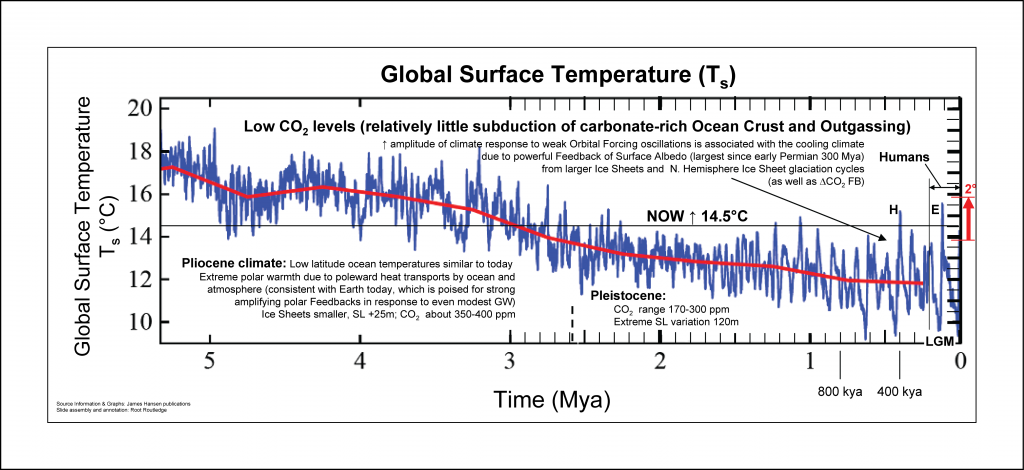A great deal of ink and angst has been spent by climate warriors and skeptics over the question of whether global warming is real, how big it is, and what to do about it. Maybe, however, these are not the right questions to be asking.
I happened recently to come across this very interesting graphic, which plots temperature for the end of the Pliocene and all of the Pleistocene (our era). This graphic is sobering — not because it shows how bad global warming is, but because it describes a multi-million-year trend that is really worrying. Here it is:
 Temperature for last 5.5 million years, plus CO2 range estimates.
Temperature for last 5.5 million years, plus CO2 range estimates.
You see, overall temperatures have been trending downward steadily, and CO2 levels as well. It has gotten to the point that the coldest ice ages have been having CO2 levels around 170ppm, which is low enough that it puts many of the plants on earth under severe carbon starvation. Indeed, there is fossil evidence of this carbon starvation from previous ice ages from articles such as this one.
If this trend were to continue, the future would look bleak for Planet Earth. As ice ages grow deeper and deeper, more and more plant species would die off as a result. Eventually, we’d have an ice age that was so deep that no terrestrial plant would survive, and Earth would become a desert planet — oscillating between ice conditions and warmer, but still barren, interglacials.
Why might this trend continue? Well, the simple answer is because tectonic processes are not adequately producing enough CO2 to sustain the carbonate-silicate cycle. The carbonate-silicate cycle recycles carbon via plate tectonics, where the two sides of the cycle involve volcanism releasing CO2, and liquid water-dependent weathering pulling CO2 out of the atmosphere. Thus, tectonics is necessary to maintain liquid water conditions on earth, and have done so for 4.5 billion years. But if you slow plate tectonics down (which happens as Earth’s core cools), then less CO2 is recycled into the atmosphere and more is trapped. The planet cools, on average, gradually over many millions of years. This appears to be what we are seeing today.
So what does this say to us? Well, for one thing, it’s actually not wrong for mankind to inject some CO2 every year into the atmosphere. Absent that, we could well be heading into the next ice age already. But even more important: this is something people may need to continue over the long haul. Estimates vary for the half-life of CO2 in the atmosphere – from 27 years to 1000 years – and mankind may well need to mindfully emit CO2 with that in mind to prevent us from falling into deeper and deeper ice ages. And finally, we really should begin to look at a CO2 level of 400ppm as a good thing, rather than a measure of doom (as some are wont to believe).
That’s not to say that rapid increases of CO2 are not worrisome. But it may well be that we’ve been looking at the end of the last century as some kind of “climate optimum” which is completely inappropriate.

I like the thought that there is no reason to believe that any period was a “climate optimum”. But what went down more than 100k years ago (when there were no humans beyond the foraging stage, as far as we know, just small bands of (proto)humans living off of the land) is obviously not relevant, you can simply cut off the leftmost 98% of this chart. What matters today is the ability to sustain agricultural production. This, we should not be shy about stating this, requires both large-scale fertilizer use and intense cultivation by machines that run on diesel. It also requires temperate climates — we simply don’t know how to do high yield agriculture in tropical or arctic climates. So a loss of temperate arable land area could matter a lot.
Site on alleged climate change….
More frightening than climate change is brainwashing of PHD’s to believe same.
Only anecdotal…intelligence does not protect you against brainwashing…the intelligence is used to decieve oneself.
https://skepticalscience.com/climate-models.htm
Off topic. Milton Freidman on immigration. Short only 3 minutes.
Milton Friedman on immigration.
https://www.youtube.com/watch?v=JQzW6DNkP_8
I am happy to see someone else asking similar questions.
It seems strange to learn that this is one of the Coldest Interglacials in over 400,000 years, in spite of our > 400ppm of CO2.
Evidence for warmer Interglacials in East Antarctic ice cores (2009)
“We conclude that previous temperature estimates from interglacial climates are likely to be too low. The available evidence is consistent with a peak Antarctic interglacial temperature that was at least 6 K higher than that of the present day —approximately double the widely quoted 3 ± 1.5 K”
http://www.nature.com/nature/journal/v462/n7271/full/nature08564.html
You can see on their graph that this CURRENT interglacial is quite a lot cooler than any other in the past 400,000 years
http://www.nature.com/nature/journal/v462/n7271/fig_tab/nature08564_F1.html#figure-title
Read it with No Paywall
https://www.researchgate.net/publication/38099943_Evidence_for_warmer_interglacials_in_East_Antarctic_ice_cores